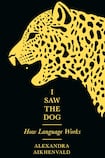
There must be a German word for the tendency to wonder if another language has a more succinct expression for the feeling or state we’re failing to fully articulate in our native tongue. A common trope on social media platforms, it can read as either hackneyed or humorous depending on the freshness of the observation at its root.
One of the most interesting facets of Alexandra Aikhenvald’s new book is its exploration of the gaps in certain languages: how German, for example, contains compound words that have no direct counterpart in English. The linguistics professor gives many examples throughout I Saw the Dog, some familiar – Schadenfreude, as “the gloating and relishing [of] someone else’s bad luck” – and others less so, such as the Russian word poriadochnyj, which describes someone who is honest, reliable and will always do the right thing. Aikhenvald maintains that there is no single word in English that captures all three qualities at once.
The subtitle of I Saw the Dog (Why Language Matters) provides a summary of the author’s intentions. As a leading linguistics expert she draws on a lifetime of fieldwork to reveal, according to the blurbs, “the mysteries and magic of language”. This somewhat overstates the scope of the book. Academic in tone, I Saw the Dog is a commendably detailed and considered piece of work, but it lacks energy and momentum.
The anecdotes aren't vibrant enough to balance the lengthy passages on the minutiae of various languages. It makes you wonder who this book is for. Those in the linguistics field will surely find it of interest, but the general reader may get lost amid the details, which include an explanation of numbers in select Austronesian languages, instructions on how to say one in Tariana using a classifier, and an anecdote about a fellow scholar (acclaimed linguist Bob Dixon) trying to underpay for a mirror in Brazil due to mistaking the gender of certain words in Portuguese. Edge of the seat it is not.
The author fares better with personal anecdotes about her time with the Tariana community on the banks of the Vaupés river in the Brazilian state of Amazonas. She is clearly an expert in their language and culture and her fears about possible extinction come through on the page, as do the difficulties of working with remote communities in far-flung locations. Aikhenvald’s love for her work (and the people she encounters) is another positive. Through her careful analysis, their way of life makes for an interesting case study.
Their intricate way of communicating, which gives the book its unusual title, is based upon principles of honour: “A Tariana who fails to be clear about how they got their knowledge will be seen as an unreliable liar.” In this era of fake news and the manipulation of the English language by former world leaders, the Tariana linguistic code seems refreshing, practically Utopian.
Aikhenvald is a professor at the James Cook University in Australia. Born in the USSR, she has worked in the Amazon region of Brazil and Papua New Guinea and speaks, among other languages, Estonian, Hebrew, Portuguese, Tariana, French, German, Yiddish and Tok Pisin, a Papuan language in which she occasionally dreams.
Linguistic sexism
The breadth of this linguistic knowledge is used to good effect in a book that is full of noteworthy trivia. We learn that spoken language is estimated to be 60,000 to 100,000 years old, in contrast to written language at about the 5,000 year mark. The division of European languages into Latin, Phoenician and Cyrillic scripts is another enlightening section. Elsewhere, tangential nuggets of information give a broader context to her arguments: “Cognitive scientists and psychologists confirm that 90 per cent of the information entering our brain is visual.”
The longest section of the book is devoted to genders in language, which “impose a way of speaking, and add precision to what one says”. Aikhenvald looks at linguistic sexism: “Masterful, mastery, masterpiece, mastermind and mastersinger. This resonates with Simone de Beauvoir’s adage: ‘Man is defined as a human being and a woman as a female – whenever she behaves as a human being she is said to imitate the male.’”
The author concludes that we’ve moved on from the default “he” to the more neutral “they”, a positive development, but she misses a beat by not discussing the latter in terms of its importance and relevance to the trans community.
The level of research that went into the book is clear from a long list of endnotes. There is no denying that Aikhenvald is devoted to her cause. I Saw the Dog is at once an ode to language and a call to action to preserve those native tongues under threat. Go n-éirí an t-ádh léi.













